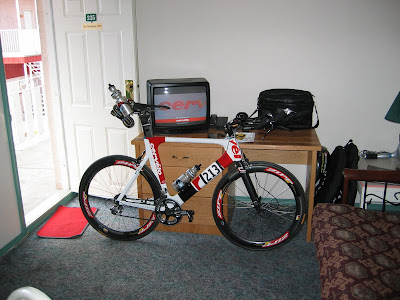Desert Half Ironman Race Report
2000m Swim, 90km Bike, 21km Run
 Above, my Cervelo P2C after a hard days' work at the Desert Half. Note the Cervelo commercial on TV; the Canadian bike company has a big presence under Team CSC at the Tour de France, and plenty of air time during the Tour coverage on OLN.
Above, my Cervelo P2C after a hard days' work at the Desert Half. Note the Cervelo commercial on TV; the Canadian bike company has a big presence under Team CSC at the Tour de France, and plenty of air time during the Tour coverage on OLN. The Desert Half Ironman promises one of the toughest bike courses around, mid-summer heat, and yesterday added brisk winds to the mix, to make for a tough but gratifying day. I finished 7th in a very competitive 45-49 age group, and 38th overall out of just under 400 finishers, in a time of 5:06:36. Considering that only seven weeks ago, I was taking my first tentative strokes in the pool after separating my shoulder in the bike crash, I'm very satisfied with the result, and particularly encouraged by a decent swim.
The Swim - Osoyoos Lake
Osoyoos Lake is the warmest lake in Canada, but thankfully wetsuits were allowed, and I'll wear my buoyant cocoon anytime I can. There was a two-wave start with the 49-and-under men hitting the water at 7:00 AM sharp, and the women and over-59 men three minutes later. I got a great draft for most of the first lap, but the pack had spread out for the second lap and fast feet were harder to get onto. As a couple of the women, marked by their yellow caps, went by, I tried to get into their draft, but they were too fast. I exited the water at 38:29 and 156th, not far off my usual half-Iron swim time and placement, so the shoulder seems to have passed the test. Now if I could just do something about my inflexible feet...
The Bike - Richter Pass to Cawston to Richter Pass to Osoyoos
Immediately after exiting transition, the road points upwards for about 15km to the crest of Richter Pass. Then an exhilirating descent down the backside, followed by a long set of rollers, and a brief flat section through the Cawston area. The course turned homeward to revisit the rollers, then the tough climb up the backside of Richter Pass, and the rewarding descent back into Osoyoos.
The wind was from the northeast, so we were faced with headwinds on the first pitch up Richter, outbound through the rollers, then again on the first return pitch up Richter. The whole ride alternated between 15-25km/h grinds up the hills, to 45-50km/h tailwind-aided flats and rollers, to 70km/h+ descents.
My ride strategy was to settle in to a steady pace on the tough sections and just grind it out, then take back time by going hard on the tailwind-aided sections and descents. This kept my heart rate pretty consistently in zone 3 (Tempo pace, 70-80% of max). I knew that with the long, wind-aided descent back into Osoyoos, I would have a chance to recover for the half-marathon to follow, so I took the risk of going hard on the final climb. My bike split was 2:49:39, good enough for 4th in my age group and 34th overall. It was a tough ride, but a lot of fun, especially with the high-speed descents.
The Run - Osoyoos Main Street and Lakefront
The two-loop run course was fairly flat, except for a short out-and-back rolling residential section at the end of each loop, that hurt as much as I anticipated it would. The route followed Main Street and along the lakefront, and there were occasional cooling breezes and timely clouds to ease the mid-day heat. I followed the fourth-place female for most of the run, which helped me hold pace, but annoyed her when my breathing went into Darth Vader mode in the last couple of km. I had a brief rough patch just before the midpoint, and negative thoughts made my resolve crumble a bit. I thought about all the people who helped me during my injury recovery, then got my legs back and my head straight. I silently thanked them all as I crossed the finish line. My run split was 1:38:29, good for 7th in the age group and 36th overall.
After doing four Ironmans in a row, it struck me after the finish how short and manageable (you'll notice I didn't say easy) the half-Iron distance is. Start at seven, finish around lunchtime. Next Sunday is the Peach Classic triathlon here in Penticton, an Olympic-distance (1500m swim, 40km bike, 10km run) event that seems easy due to the length, but must be raced at a higher intensity. Short, but sharp. I'll preview that race later in the week.
In the meantime, today is a recovery day for me, but Ironspirit training camp starts for about twenty other people who will be doing lactate threshhold testing at the Impact Endurance Training Center. Athletes need to be rested to get meaningful results, because the testing requires a maximal effort. My maximal effort today will be an easy spin on the bike, maybe a refreshing dip in the lake, and a lot of stretching. The serious training resumes tomorrow with a long swim, interval run session, then a moderate-pace bike ride. More to follow...
Tour de France observations
I've been following the Tour closely, and watched with horror today as a massive pileup occurred in the last couple of km. The worst thing was seeing so many riders in the aftermath, riding into the finish line holding one arm immobile in close to the body (Including yellow jersey Fabian Cancellera); a common sign of a broken collarbone or separated shoulder. Guys, I feel your pain.












